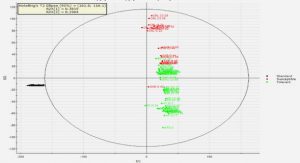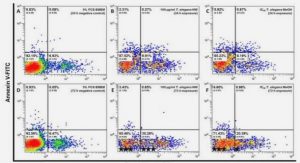Get Complete Project Material File(s) Now! »
Hydantocidin Analogues
(+)-Hydantocidin (465) is a naturally occurring spironucleoside isolated from the culture broth of Streptomyces hygroscopicus. It exhibits potent growth inhibition and herbicidal activity against annual, perennial, monocotyledonous and dicotyledonous weeds with a similar efficacy to that of glyphosate while showing low toxicity against fish and mice.83 Once phosphorylated, it competitively inhibits adenylosuccinate synthetase (AdSS) which catalyses the GTP-dependent conversion of inosine monophosphate (IMP) and aspartic acid to adenosine monophosphate (AMP)—the de novo purine synthesis of the target plant.86 AdSS is also the target for therapeutic agents such as L-alanosine87 (antitumour, antiviral, antibiotic and immunosuppressive agent) and hadacidin88 (antitumour agent, antibiotic and plant growth inhibitor).
3′-Spironucleosides—TSAO Nucleoside Analogues
[2′,5′-Bis-O-(tert-butyldimethylsilyl)-β-D-ribofuranose]-3′-spiro-5′′-[4′′-amino-1′′,2′′-oxathiole2′′,2′′-dioxide] (TSAO) nucleosides are synthetic 3′-spironucleosides with a potent anti-HIV-1 activity. They target the hydrophobic allosteric non-substrate binding site located near the polymerase active site. Intracellular phosphorylation was not required and they possess similar properties to those of the HIV-1 specific non-nucleoside reverse transcriptase inhibitors (NNRTIs).23,85 Initial synthesis started with the transformation of bis-TBS-protected nucleoside 507 into cyano mesylate. However, a mixture of 3′-epimer was obtained with the desired (3′S)-ribo epimer isolated as the minor product.95 In the revised strategy, treatment of cyclopentanone 508 with cyanide and mesylation gave the desired (3′S)-cyano mesylate 509 as the only stereoisomer. Acetonide removal, acetylation and nucleosidation under Vorbrüggen conditions gave nucleosides 510.
4′-Spironucleosides—Paquette’s Spirocyclic Nucleosides
Paquette’s research group conducted extensive diversity oriented synthesis (DOS) studies on a range of 4′-spirocyclic nucleosides including oxacycles, thiacycles and carbacycles (Figure 2.7). These molecules feature conformational restrictions in order to achieve better ring puckering and mimicking the optimal C4′–C5′ torsion angle of the furanose (equivalent to C5′–C6′ of the spirocyclic system). Both of these properties have an important role in the sugar-phosphate nucleic acid backbone and may control the secondary structure of nucleic acid and base recognition. Alkylation at C4′ of the furanose (equivalent to C5′ of the spirocyclic system) also inhibits radical-induced hydrogen atom abstraction/degradation of the nucleic acid. Carba and thiacyclic nucleosides also offer additional stability against metabolic degradation due to the absence or strengthening of glycosidic lineage.
Alternative Use of Azides—Staudinger Reactions
Apart from its utilisation in cycloaddition, organic azides are also useful starting materials for various reactions which provide alternative routes for diversity oriented synthesis (DOS) starting from a common intermediate. Among those, the Staudinger reaction is one of the important examples and it usually refers to a mild reduction of azide 755 to amine 759 using phosphine as reducing agent. The mechanism of this reduction involves the hydrolysis of aza-ylide intermediate 758, generated by the addition of phosphine to azide 755 with concomitant loss of nitrogen gas (Scheme 3.20). This reaction is a convenient metal free alternative to the metal-catalysed reduction/hydrogenation of azides.73
Research Opportunities Based on SpiroacetalTriazoles and Amino Acid Analogues
This chapter has provided an overview regarding the biology and chemistry of triazole and amino acid analogues supported with selected examples. As previously mentioned, we were interested in the chemical attachment between biologically useful subunits. With the structural features offered by 6,6-spiroacetals and the benefit of triazole and amino acid moieties, the hybrid of these motifs might lead to potentially interesting bioactivity. Both moieties can be, in theory, synthesised from a common azide intermediate and this represents a good opportunity for the diversity oriented synthesis. The following chapters will discuss, in detail, the synthesis of these spiroacetal-triazoles and amino acids as well as spiroacetal-nucleobases. The aim of the current research will be first examined, followed by the model studies embarked for feasibility purpose, and finally the target hybrids that we were interested in.
Table of Contents :
- Preface
- Abstract
- Acknowledgements
- Abbreviations and Acronyms
- Table of Contents
- CHAPTER 1: INTRODUCTION: CHEMISTRY OF SPIROACETALS
- 1.1 Why do we Modify Natural Products?
- 1.2 6,6-Spiroacetals
- 1.2.1 Naturally Occurring 6,6-Spiroacetals (“Spiroacetals”)
- 1.2.2 Biologically Active Synthetic 6,6 Spiroacetals
- 1.3 Stereochemistry of 6,6-Spiroacetals
- 1.3.1 Stereoelectronic Effects
- 1.4 Synthesis of 6,6-Spiroacetals
- 1.4.1 Cyclisation of Hydroxyketones or their Equivalent [A]
- 1.4.2 Intramolecular Hetero-Michael Addition (IHMA) [B]
- 1.4.3 Reductive Cyclisation [C]
- 1.4.4 Cyclisation of Enol Ethers and Glycals [D]
- 1.4.5 Cyclisation by Hetero-Diels-Alder Reaction (HDA) [E]
- 1.4.6 Cyclisation by Ring Closing Metathesis (RCM) [F]
- 1.4.7 Intramolecular Hydrogen Abstraction (IHA) [G]
- 1.4.8 Oxidative Ring Expansion [H]
- 1.5 Diversity-Oriented Synthesis of 6,6-Spiroacetals
- 1.5.1 An Early Example
- 1.5.2 Process-driven Generation of Spiroacetal Libraries during the Development of Synthetic Methods
- 1.5.3 Product-driven Systematic Generation of Spiroacetal Libraries
- 1.6 Research Opportunities Based on the Use of 6,6-Spiroacetal Analogues
- 1.7 References
- CHAPTER 2: INTRODUCTION: NUCLEOSIDES
- 2.1 Viruses and Diseases
- 2.1.1 The Structure of a Virus
- 2.1.2 The Replication Cycle of a Virus
- 2.1.3 Prevalence of Diseases Caused by Viruses
- 2.2 Antiviral Therapy
- 2.2.1 Targets for Selective Toxicity
- 2.3 Nucleoside Analogues
- 2.3.1 Nucleosides, Nucleotides and Nucleic Acids
- 2.3.2 Basic Structure of Nucleoside Analogues
- 2.3.3 Examples of Clinically Used Antiviral Nucleoside Analogues
- 2.4 Synthesis of Nucleoside Analogues
- 2.4.1 Nucleosidation under Vorbrüggen Conditions [A]
- 2.4.2 Electrophilic Addition [B]
- 2.4.3 Metal Salt Procedure [C]
- 2.4.4 Mitsunobu Reaction [D]
- 2.5 Pyran-based Nucleoside Analogues
- 2.6 Spirocyclic Nucleoside Analogues
- 2.6.1 1′-Spironucleosides—Hydantocidin Analogues and other Novel Examples
- 2.6.2 2′-Spironucleosides
- 2.6.3 3′-Spironucleosides—TSAO Nucleoside Analogues
- 2.6.4 4′-Spironucleosides—Paquette’s Spirocyclic Nucleosides
- 2.7 Research Opportunities Based on 6,6-Spiroacetal Nucleoside Analogues
- 2.8 References
- 2.1 Viruses and Diseases
- CHAPTER 3: INTRODUCTION: TRIAZOLES AND AMINO ACIDS
- 3.1 Amino Acids in Brief
- 3.1.1 Structures of Amino Acids
- 3.1.2 Peptide Bonds
- 3.2 1,2,3-Triazoles
- 3.2.1 Applications of Triazole Containing Derivatives
- 3.3 Click Chemistry
- 3.4 Synthesis of Triazoles
- 3.4.1 Huisgen’s 1,3-Dipolar Cycloadditions
- 3.4.2 Copper-Catalysed Azide-Alkyne 1,3-Dipolar Cycloaddition (CuAAC)
- 3.4.3 Aspects of CuAAC reaction
- 3.4.4 Mechanisms of CuACC
- 3.4.5 Selected Examples of CuAAC
- 3.4.6 One-pot Synthesis of Triazoles
- 3.4.7 Synthesis of 1,5-Disubstituted and 1,4,5-Trisubstituted Triazoles
- 3.5 Alternative Use of Azides—Staudinger Reactions
- 3.5.1 Selected Examples of Staudinger Reaction/Ligation
- 3.6 Research Opportunities Based on Spiroacetal-Triazoles and Amino Acid Analogues
- 3.7 References
- 3.1 Amino Acids in Brief
- CHAPTER 4: AIM OF PRESENT RESEARCH
- CHAPTER 5: DISCUSSION: SYNTHESIS OF THE MODEL SPIROACETALS
- 5.1 Retrosynthetic Analysis of Spiroacetal Heterocycle Models 811 and
- 5.1.1 Retrosynthesis
- 5.1.2 Nucleophilic Addition to an Oxonium Ion Generated From an Activated
- Spiroacetal
- 5.2 Synthesis of Oxaspirolactone
- 5.2.1 Previous Synthesis of Oxaspirolactone
- 5.2.2 Synthesis of Keto-Acid
- 5.2.3 Synthesis of Oxaspirolactone
- 5.3 Synthesis of Spiroacetal Acetate 815 and Ethoxy-Spiroacetal
- 5.3.1 Synthesis of Spiroacetal Acetate
- 5.3.2 Synthetic Routes to Ethoxy-Spiroacetal
- 5.3.3 The First Approach to the Synthesis of Ethoxy-Spiroacetal 817 from Oxaspirolactone
- 5.3.4 The Second Approach to the Synthesis of Ethoxy-Spiroacetal 817 from KetoAldehyde
- 5.3.5 NMR and Stereochemistry of Spiroacetal Acetate 815 and Ethoxy-Spiroacetal
- 5.4 Synthesis of Spiroacetal-Nucleosides
- 5.4.1 Nucleosidation of Spiroacetal Acetate
- 5.4.2 Nucleosidation of Ethoxy-Spiroacetal
- 5.4.3 Comparison of the Use of Spiroacetal Acetate 815 and Ethoxy-Spiroacetal 817 for Nucleosidation Reactions
- 5.4.4 NMR and Stereochemistry of Spiroacetal 5-Fluorocytidine 811a and Uridine 811d
- 5.5 Synthesis of Spiroacetal Triazoles
- 5.5.1 Preparation of Azido-Spiroacetal
- 5.5.2 NMR and Stereochemistry of Azido-Spiroacetals
- 5.5.3 Cycloadditions of Azido-Spiroacetals
- 5.5.4 NMR and Stereochemistry of Triazoles
- 5.1 Retrosynthetic Analysis of Spiroacetal Heterocycle Models 811 and
- CHAPTER 6: DISCUSSION: SYNTHESIS OF FUNCTIONALISED SPIROACETALS
- CHAPTER 7: EXPERIMENTAL
GET THE COMPLETE PROJECT
Analogues of Natural Product-like Scaffolds: Synthesis of Spiroacetal Derivatives






